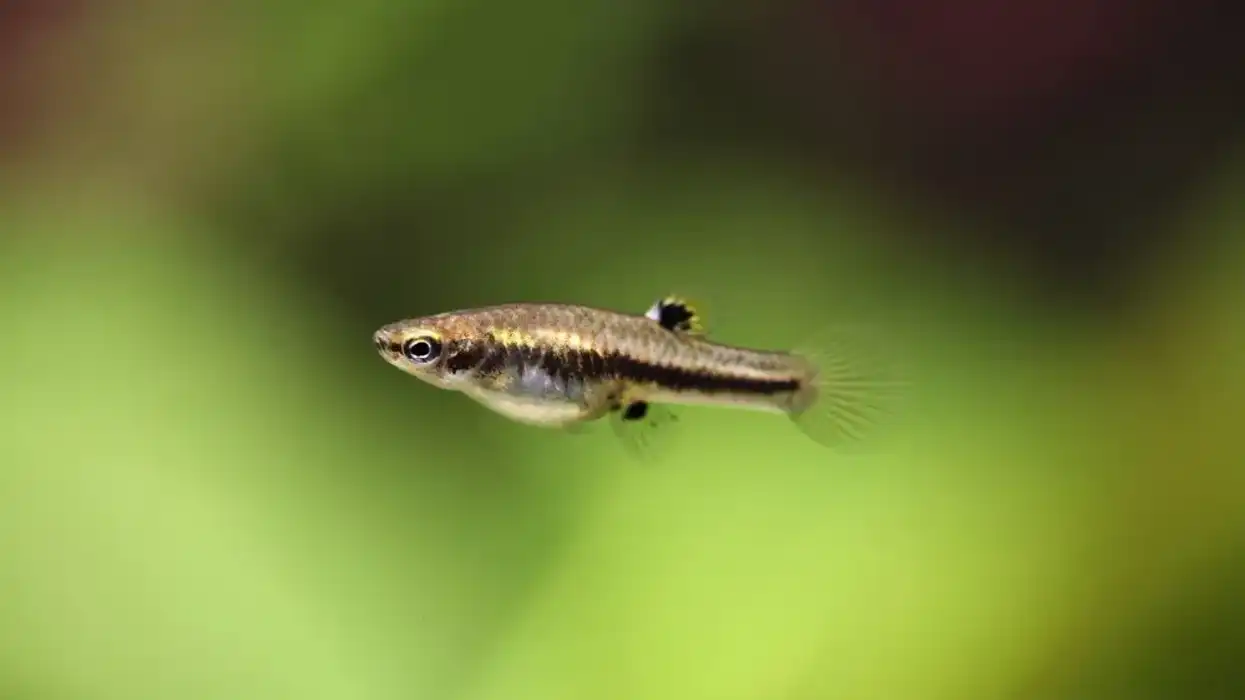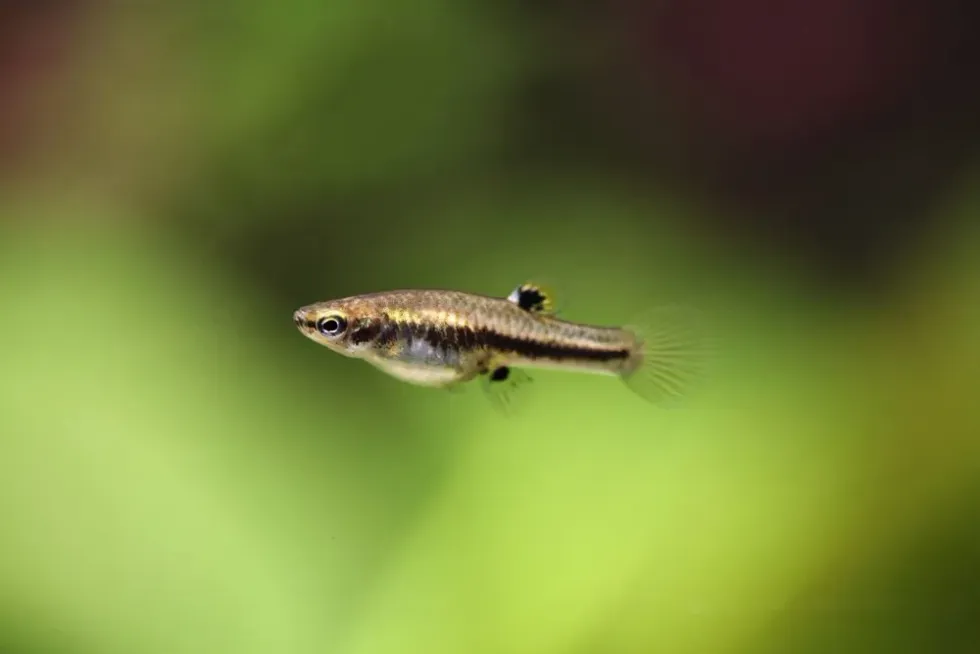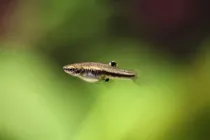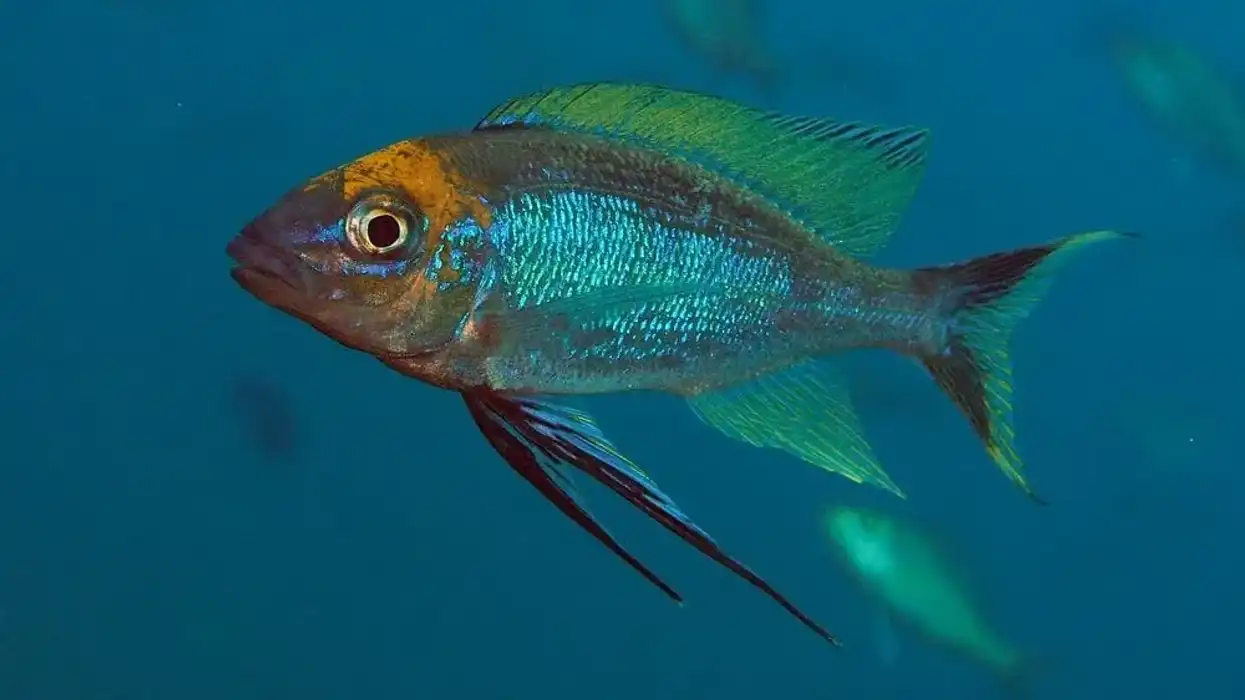Fun Least Killifish Facts For Kids

The least killifish (Heterandria formosa) is one of the smallest live-bearing species of fish that can be found in the United States, especially in the regions of Florida. These small fish do not do well in large community tanks and should be kept in an aquarium or a tank with slow-moving water.
Females are slightly larger in size than males and females give birth to live young ones through a unique process of superfetation.
These livebearers are typically omnivorous by nature and the least killifish diet includes other invertebrates and various plants. Other than freshwater habitats, they can also be found in brackish waters.
They are also known by the names of 'dwarf livebearer' and 'dwarf top minnow'.
The least killifish are not generally aggressive and are quite peaceful and shy by nature. The least killifish tank and aquarium must contain water of a low current so that they can move comfortably.
If you are fascinated by the least killifish, then you may want to read the following amazing facts about them. If you want to learn more about different animals, you can read up on these eel facts and blobfish facts.
Least Killifish Interesting Facts
What type of animal is the least killifish?
The least killifish is a species of fish that is native to the regions of North America. They belong to the family of Poeciliidae and are of the genus Heterandria.
What class of animal does the least killifish belong to?
The least killifish belongs to the Actinopteyrigii class of animals. The least killifish scientific name is Heterandria formosa.
How many least killifish are there in the world?
The exact population of this species in this world is unknown. However, they are a regular sight in households or natural habitats like freshwater and brackish water habitats of the United States. They are extremely peaceful and are kept frequently as domestic fish in aquariums or tanks by the people of that region.
Where does the least killifish live?
The least killifish school can be found in habitat regions of the southeastern United States, Georgia, Florida, and the habitat regions of Louisiana. Recently, they have been introduced in the regions of Texas, as well. They can be found both in the natural habitat like a river, as well as in an aquarium.
What is the least killifish's habitat?
The least killifish habitat includes both freshwater regions as well as brackish waters. One of the main differences between brackish waters and freshwater habitats is that brackish waters contain more salinity than freshwater.
Who do the least killifish live with?
This specie of fish swim together and do well when kept with other species of fish, of similar size. However, they should never be kept in tanks or aquariums which contain other large-sized species of fish. This is because those large-sized fish can prey on the least killifish or their younger ones.
How long does the least killifish live?
The average lifespan of the least killifish is generally three or more than three years, in their natural habitat where it feeds on plants and other invertebrates. They can be found both in households as well in freshwater habitats of the United States.
One of the most interesting facts about this species is that they can even survive in brackish water. One of the main differences between freshwater and brackish water is that freshwater habitats contain a lower amount of salinity than brackish water.
How do they reproduce?
This species of fish are livebearers, that is, they give birth to live young ones in the water. They reproduce or give birth to offspring through a unique process of superfetation, which means they do not release all their young ones, at once.
Instead, they give birth to one or a small group of younger ones over a long period of time. A batch of 40 offsprings is released over a 10-14 days period of time.
What is their conservation status?
The least killifish, which is one of the smallest livebearer fish is currently listed as Least Concern species by the International Union for Conservation of Nature (IUCN). This is because they are found in natural habitats of freshwater and brackish waters, along with being kept as pets in many households.
Least Killifish Fun Facts
What do the least killifish look like?
The wild least killifish, belonging to the family of Poeciliidae, is considered to be one of the tiniest species to exist on this planet. This family includes the guppy fish and swordtail fish.
Their small bodies are generally olive in color, with a dark-colored horizontal line running through the center of their body. They are bright-colored fish and their dorsal fins are covered with dark spots.
Anal fins of a female also contain a similar-looking dark spot. They are considered to be the seventh tiniest species of fish in the world.
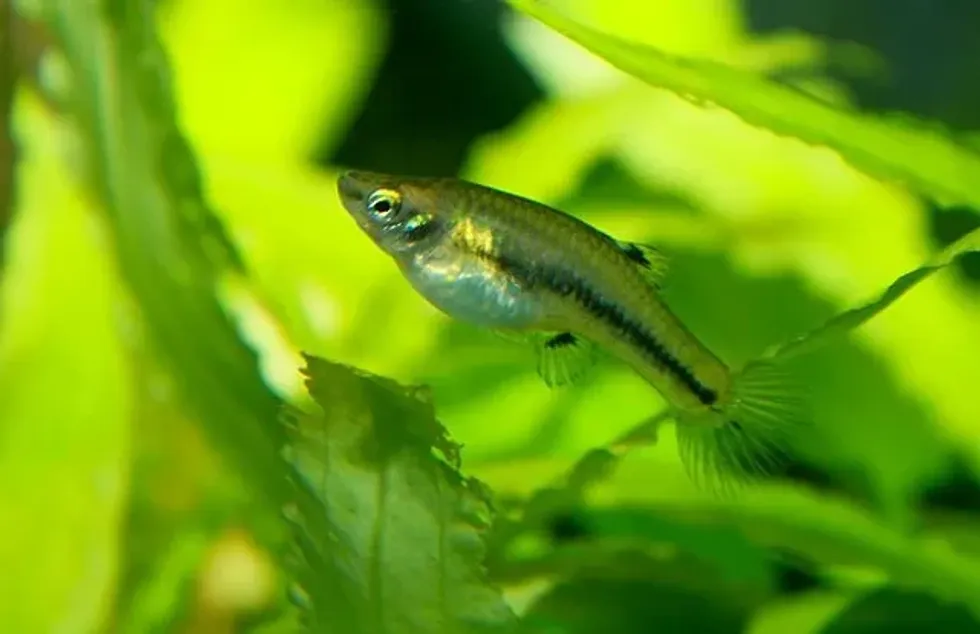
How cute are they?
They are extremely cute and very often kept on display in an aquarium or tank with the right water parameters. Their unique features are their bright-colored bodies and their tiny size, both of which make this species of fish adorable to look at.
The dark spots that are present on their dorsal fins, enhance their beauty further. They are also extremely peaceful by nature and can be kept as a pet along with other similar-sized species of fish.
How do they communicate?
Like all other species of fish, these livebearers too possess the hearing ability. They communicate with each other by using a variety of gestures and motions. They are generally shy-natured, small, and peaceful kinds of fish.
How big is the least killifish?
The least killifish is one of the tiniest fish in the world and their size differs from male to female. The least killifish male is typically smaller in size than the female, growing up to a size of only 0.8 in (2 cm).
The female of this species, on the other hand, is slightly larger and can grow up to a size of 1.2 in (3 cm). This species of small fish are even smaller in size than the mosquitofish, who belong to the same family of Poeciliidae.
How fast can the least killifish swim?
The exact speed of this species of fish not known. However, because of their tiny size, the water of those tanks and aquariums needs to be of a low current, so that it won't cause any hindrance in their movement. They cannot survive in strong current water because of their tiny size.
How much does the least killifish weigh?
The weight of this species is unknown.
What are the male and female names of the species?
There is no sex-specific name for this species of fish. Males are called male fish and females are called female fish.
What would you call a baby least killifish?
Like other species of fish, a baby least killifish is called a fry. Females have quite a unique process of giving birth to their offsprings.
They do not give birth at once, instead, they take a prolonged period of time to give birth to a large fry of younger ones. This process is known as superfetation. The least killifish fry can very often fall prey to large-sized species of fish when they are kept together in the same enclosed environment.
What do they eat?
Found in the regions of South Carolina, among many others, the least killifish is one of the smallest fish in the world and is omnivorous by nature. Their diet includes both plants as well as small invertebrates, like worms and crustaceans, equally.
Feeding the least killifish is not a problem either, as they can survive almost on anything. For this reason, they turn out to be good pets and do not require much maintenance.
Are they aggressive?
No, these livebearer species of fish are not aggressive by nature. Rather, they are shy and reserved. They tend to do well in aquariums that are filled with other similar-sized fish. Keeping other large-sized species of fish in the same aquarium can pose a threat to the young ones of this species.
Would they make a good pet?
Yes, the least killifish (Heterandria formosa) is a good pet. They can easily adapt to their environment and are not picky eaters.
Because of their bright-colored body, many households keep them as pets in tanks or aquariums and they do quite well there. They are not aggressive and instead, are shy and can do well with other small species as well.
The least killifish tank size does not matter as long as they are kept with other similar-sized fish, because their small size may allure other large fish to feed on them and their babies. They are social animals and do not create much of a hassle for their owners.
The least killifish care is not very demanding and hence, keeping them as pets, is quite common in many households. Feeding these killifish is not a problem either as they can survive almost on anything.
Did you know...
Although, according to their name, the least killifish should be a part of the 'killifish' family, they belong to the family of Poeciliidae, which is a family of aquarium fish like guppies and mollies.
Not much care is needed when one wants to keep the least killifish as a pet. They are extremely tiny in size, therefore, tanks or aquariums with a slow movement of water are required for them to move at ease.
Tanks with string filters will cause a hindrance to their movement and will not allow them to move freely. These species are omnivorous by nature.
Their diet includes a large variety of plants as well as small invertebrates. They are not generally picky eaters, so feeding them does not pose a problem for their owners.
Mosquitofish and the least killifish both belong to the same family of Poeciliidae. However, the mosquitofish are larger in size than the least killifish, growing up to a length of 2.8 in (7 cm). Males of the mosquitofish are smaller in size than the female mosquitofish and can reach up to the length of 1.6 in (4 cm).
Found in the regions of South Carolina, among many others, this fish species can live in a 5-gallon tank (19 l) or more than a 5-gallon tank (19l +). However, the water needs to be of low current, for them to move at ease.
A group of three male least killifish cost $11.95 USD.
What is unique about the least killifish?
Found in North America, the least killifish (H. formosa) belongs to the family of Poeciliidae. This fish species is well known not just because they are known to be one of the tiniest fishes in the world, but also because they are livebearers, which means they give birth to live young ones in the water.
Another unique thing about Heterandria formosa is that females do not give birth to all young ones at once, instead, they continue the process for a longer period of time.
A group of 40 offsprings may be born over a period of 10-14 days.
This process is known as superfetation. The least killifish size differs from males to females, where the males of this species are usually smaller in size than the females.
Water conditions for a least killifish
The least killifish freshwater fish (H. formosa) can also be found in brackish water. Brackish waters contain more percentage of salinity than freshwater habitats.
Very often, this peaceful species of fish can also be found in households, swimming in an aquarium, or a tank with the right water parameters. The ideal water parameters of the least killifish aquarium and tank are 66- 75℉ (18-24°C ), with a pH level of 7.0.
They can also manage to live in a water temperature of 50- 90℉ (10-32°C).
Here at Kidadl, we have carefully created lots of interesting family-friendly animal facts for everyone to discover! For more relatable content, check out these American shad facts and milkfish facts pages.
You can even occupy yourself at home by coloring in one of our free printable least killifish coloring pages.
We Want Your Photos!
More for You
See All
Bachelor of Arts specializing in Journalism and Mass Communication, Postgraduate Diploma in Sports Management

Moumita DuttaBachelor of Arts specializing in Journalism and Mass Communication, Postgraduate Diploma in Sports Management
A content writer and editor with a passion for sports, Moumita has honed her skills in producing compelling match reports and stories about sporting heroes. She holds a degree in Journalism and Mass Communication from the Indian Institute of Social Welfare and Business Management, Calcutta University, alongside a postgraduate diploma in Sports Management.
Bachelor of Arts specializing in Economics

Gowri RaoBachelor of Arts specializing in Economics
With a bachelor's degree in Economics from Krea University, Gowri is a highly skilled data analyst and an expert in regression and causation modeling. Her interests in economic trends, finance, and investment research complement her professional expertise. In addition to her professional pursuits, Gowri enjoys swimming, running, and playing the drums, and she is also a talented tutor.
Disclaimer
1) Kidadl is independent and to make our service free to you the reader we are supported by advertising. We hope you love our recommendations for products and services! What we suggest is selected independently by the Kidadl team. If you purchase using the Buy Now button we may earn a small commission. This does not influence our choices. Prices are correct and items are available at the time the article was published but we cannot guarantee that on the time of reading. Please note that Kidadl is a participant in the Amazon Services LLC Associates Program, an affiliate advertising program designed to provide a means for sites to earn advertising fees by advertising and linking to Amazon. We also link to other websites, but are not responsible for their content.
2) At Kidadl, we strive to recommend the very best activities and events. We will always aim to give you accurate information at the date of publication - however, information does change, so it’s important you do your own research, double-check and make the decision that is right for your family. We recognise that not all activities and ideas are appropriate for all children and families or in all circumstances. Our recommended activities are based on age but these are a guide. We recommend that these ideas are used as inspiration, that ideas are undertaken with appropriate adult supervision, and that each adult uses their own discretion and knowledge of their children to consider the safety and suitability. Kidadl cannot accept liability for the execution of these ideas, and parental supervision is advised at all times, as safety is paramount. Anyone using the information provided by Kidadl does so at their own risk and we can not accept liability if things go wrong.
3) Because we are an educational resource, we have quotes and facts about a range of historical and modern figures. We do not endorse the actions of or rhetoric of all the people included in these collections, but we think they are important for growing minds to learn about under the guidance of parents or guardians.
